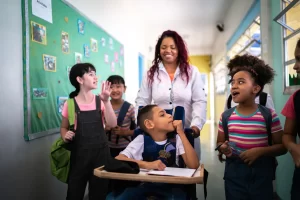
Special Education Needs: Meaning, Types and Importance; Special education needs encompass a wide range of requirements for students who have disabilities or learning challenges.
These needs might include physical, emotional, behavioral, or cognitive difficulties that affect a student’s ability to learn in a traditional classroom setting.
Effective special education programs are tailored to meet these unique needs through individualized instruction and specialized resources.
In today’s educational landscape, special education needs (SEN) play a crucial role in ensuring that all students receive the support they need to thrive academically and socially.
This article explores what special education needs entail, the types of support available, and its importance.
What Are Special Education Needs?
Special education needs refer to the specific requirements of students who have learning difficulties or disabilities that make it harder for them to learn compared to their peers.
These needs can arise from various conditions, including but not limited to autism spectrum disorders (ASD), dyslexia, ADHD, hearing impairments, and physical disabilities.
Understanding these needs is essential for creating an effective learning environment that promotes equity and supports diverse learning styles.
Types of Special Education Needs
Special education needs (SEN) encompass a broad spectrum of conditions that can impact a student’s ability to learn effectively.
Understanding the types of special education needs helps educators, parents, and caregivers provide appropriate support and interventions.
This section explains various types of special education needs and their implications for teaching and learning.
1. Learning Disabilities:
Learning disabilities are neurodevelopmental disorders that affect how individuals process information. Common learning disabilities include:
Dyslexia:
This refers to difficulty with reading due to challenges in decoding and recognizing words.
It is a specific learning disability that impacts reading and language processing. Students with dyslexia often struggle with decoding words and reading fluently.
Specialized reading programs and multisensory instruction are crucial for these students.
Techniques like Orton-Gillingham and Wilson Reading System can help improve reading skills and comprehension.
Dysgraphia:
This has to do with Issues related to writing that can affect handwriting, spelling, and composition.
Dyscalculia:
This is difficulty with math concepts, including number sense and arithmetic operations.
2. Autism Spectrum Disorder (ASD):
Autism Spectrum Disorder is a developmental disorder characterized by challenges in social interaction, communication, and repetitive behaviors.
Individuals with ASD may have varying levels of intellectual ability and require personalized educational strategies to support their unique learning needs.
3. Attention-Deficit/Hyperactivity Disorder (ADHD):
ADHD is a behavioral disorder marked by persistent patterns of inattention, hyperactivity, and impulsivity.
Students with ADHD may struggle with organization, staying focused, and completing tasks, necessitating tailored classroom strategies to help manage their symptoms and enhance learning outcomes.
4. Intellectual Disabilities:
Intellectual disabilities involve limitations in intellectual functioning and adaptive behavior.
These disabilities can affect reasoning, problem-solving, and everyday functioning.
Support for students with intellectual disabilities often includes specialized teaching methods and individualized education plans (IEPs) to accommodate their learning pace and style.
5. Emotional and Behavioral Disorders:
Emotional and behavioral disorders (EBD) encompass a range of conditions affecting mood and behavior, such as:
Anxiety Disorders: Excessive worry or fear that interferes with daily functioning.
Depressive Disorders: Persistent feelings of sadness or hopelessness.
Conduct Disorders: Behavioral issues involving aggression, rule-breaking, and defiance.
Effective strategies for supporting students with EBD involve creating a structured, supportive classroom environment and implementing behavioral interventions.
6. Sensory Processing Disorders:
Sensory processing disorders affect how individuals perceive and respond to sensory stimuli.
Students with these disorders may have heightened or diminished responses to sensory input, such as sounds, textures, or lights.
Educators can support these students by adapting classroom environments to minimize sensory overload and using sensory-friendly tools and activities.
7. Speech and Language Disorders:
Speech and language disorders impact communication skills and can include:
Articulation Disorders: These involve inability to pronounce sounds correctly.
Language Disorders: Students have challenges with understanding or using spoken or written language.
Fluency Disorders: Special students who face these challenges have Issues with stuttering that affect the flow of speech.
Speech therapy and targeted interventions can help students improve their communication abilities and participate more fully in classroom activities.
To conclude, having knowledge of the various types of special education needs is essential for providing effective support and creating an inclusive educational environment.
By recognizing and addressing these needs, educators and caregivers can help all students achieve their full potential.
Implementing individualized strategies and accommodations ensures that each student receives the support they need to succeed academically and socially.
Types of Special Education Support
Special education support is crucial in ensuring that students with diverse learning needs receive the education they deserve.
Understanding the various types of special education support can help educators, parents, and guardians create an effective learning environment tailored to each student’s unique needs.
In this section, we will explore the key types of special education support available and how they benefit students.
1. Individualized Education Program (IEP):
An Individualized Education Program (IEP) is a legally mandated plan developed for each student with a disability.
The IEP outlines specific educational goals, accommodations, and modifications tailored to the student’s needs.
This personalized plan is created by a team that includes teachers, parents, and special education professionals.
The IEP ensures that students receive targeted support, enabling them to achieve their academic and developmental goals.
2. 504 Plan:
A 504 Plan provides accommodations and modifications to students with disabilities that do not qualify for special education services under the Individuals with Disabilities Education Act (IDEA).
Unlike the IEP, a 504 Plan is designed to ensure that students with disabilities have equal access to education.
Accommodations may include extended test times, preferential seating, or additional assistance with assignments.
3. Resource Room Support:
Resource room support involves providing students with specialized instruction in a separate classroom setting.
In this model, students receive focused help from special education teachers or specialists in areas such as reading, math, or writing.
Resource room support is beneficial for students who need individualized attention and targeted instruction to address specific learning challenges.
4. Inclusion Support:
Inclusion support involves integrating students with disabilities into general education classrooms while providing additional support as needed.
This approach promotes social interaction and academic collaboration between students of varying abilities.
Inclusion support often includes co-teaching models, where general education and special education teachers work together to address the diverse needs of all students in the classroom.
5. Speech and Language Therapy:
Speech and language therapy addresses communication disorders that affect a student’s ability to speak, understand, or use language effectively.
Speech-language pathologists work with students to improve articulation, fluency, language comprehension, and social communication skills.
This type of support is essential for students who struggle with speech or language-related challenges.
6. Occupational Therapy:
Occupational therapy helps students develop the skills needed for daily living and academic tasks.
This support focuses on improving fine motor skills, sensory processing, and coordination.
Occupational therapists work with students to enhance their ability to participate in classroom activities, such as writing, using classroom tools, and performing self-care tasks.
7. Behavioral Therapy:
Behavioral therapy addresses challenging behaviors that may impact a student’s learning and social interactions.
This type of support involves implementing strategies to promote positive behavior and reduce disruptive actions.
Behavioral therapists work with students to develop coping skills, self-regulation techniques, and effective communication methods.
8. Assistive Technology:
Assistive technology encompasses a range of tools and devices designed to support students with disabilities.
This can include software applications, communication devices, and adaptive equipment that help students access the curriculum and participate in classroom activities.
Assistive technology is tailored to meet individual needs, enhancing students’ ability to learn and engage effectively.
Knowing the types of special education support available is essential for creating an inclusive and effective learning environment.
By leveraging Individualized Education Programs (IEPs), 504 Plans, resource room support, inclusion support, speech and language therapy, occupational therapy, behavioral therapy, and assistive technology, educators and parents can work together to meet the diverse needs of students with disabilities.
This will ensure that each student receives the appropriate support that helps them thrive academically and socially, paving the way for a successful educational journey.
The Importance of Addressing Special Education Needs
Addressing special education needs is vital for ensuring that every student has the opportunity to succeed.
By providing targeted support and resources, educators can help students overcome challenges and reach their full potential.
Below is some importance of addressing special education needs.
Enhancing Academic Achievement:
One of the primary benefits of addressing special education needs is the enhancement of academic achievement.
Students with special education needs often require customized learning strategies to grasp complex concepts and complete assignments.
By implementing individualized education programs (IEPs) and providing specialized support, educators can help these students overcome barriers to learning and achieve their full potential.
Promoting Inclusivity and Equality:
Inclusive education is a cornerstone of addressing special education needs. It ensures that all students, regardless of their abilities, have access to the same educational opportunities.
By integrating students with special education needs into regular classrooms, schools promote a culture of inclusivity and equality.
This approach not only benefits students with disabilities but also fosters empathy and understanding among their peers.
Supporting Social and Emotional Development:
Addressing special education needs goes beyond academic support; it also plays a crucial role in the social and emotional development of students.
Specialized programs and therapies can help students build self-esteem, develop social skills, and manage emotional challenges.
This support is essential for creating a positive learning environment where students feel valued and confident.
Legal and Ethical Considerations:
From a legal perspective, schools are required to address special education needs under laws such as the Individuals with Disabilities Education Act (IDEA) in the United States.
This legislation mandates that schools provide appropriate accommodations and modifications to support students with disabilities.
Fulfilling these legal obligations is not only a requirement but also an ethical responsibility to ensure that every student has an equal opportunity to succeed.
Conclusion (Special Education Needs: Meaning, Types and Importance)
Special education needs encompass a broad range of requirements for students who face unique learning challenges.
By understanding these needs and implementing effective support strategies, educators can create an inclusive and equitable learning environment.
For parents, teachers, and policymakers, prioritizing SEN is essential for fostering academic success and personal growth for all students.
In conclusion, addressing special education needs is essential for creating an equitable and effective educational system.
By enhancing academic achievement, promoting inclusivity, supporting social and emotional development, and fulfilling legal and ethical obligations, schools can ensure that all students receive the education they deserve.
Investing in special education not only benefits individual students but also enriches the entire educational community, paving the way for a more inclusive and compassionate society.


Add comment